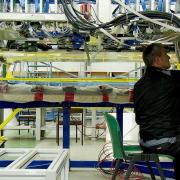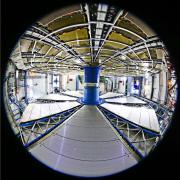Access to Collaboration Site and Physics Results

Hold out your hand and in one minute hundreds of muons will have passed through your palm. Muons are one of the high-energy cosmic ray particles that can pass through most solid structures – even the ATLAS detector’s calorimeter, which is designed to absorb particles and measure their energy. A specific system is required to measure muons. Until now, the ATLAS muon system was almost completed, but not quite. The last of the 62 chambers in the Extended Endcap (EE) region was installed just before summer this year.
The EE chambers have been placed in an angular region between the endcap and the barrel of the muon spectrometer, which was not previously well-covered. Muons release only a tiny fraction of their energy when passing through the ATLAS detector’s calorimeter.

The muon spectrometer, which sits just outside of the calorimeter, is encompassed in an enormous toroidal magnet system. The field from these magnets serve to bend the trajectory of the muons, allowing physicists to measure their momentum.
At least three measured points are needed to define the bending of a muon trajectory and in the EE region, the muon system had only provided two. The bending is especially important because the momentum of muons is measured by the amount of bending made.
"The resolution of the measured momentum suffered from the absence of a third measured point, but now, with the EE chambers in place, we will have more accurate and more precise momentum determination," says Ludovico Pontecorvo, ATLAS Muon System Project Leader.
Improved measurements of muon momentum ultimately means improved measurements of particles that decay into muons, such as the newly discovered Higgs boson, and a variety of other particles potentially awaiting discovery.
Since the LHC’s first run in 2010, the Muon System and Technical Coordination teams have been working during successive stops and Christmas breaks, installing parts of the EE chambers. The installation process itself was no easy task since the detector was already built and the space where some of the chambers needed to go weren’t easily accessible. Adding to the challenge was the sheer size of the chambers – up to 4m by 3m, with a width of 70cm, weighing a ton each.
The only way to put some of the chambers was to go to the top of the ATLAS experiment, where there was a small aperture, much less than 4m across but more than 70cm wide. Each chamber had to be manipulated to a precise angle before being manoeuvred through this aperture and slid down carefully (remember, they weigh a ton each!) on curved rails and brought into position. There were eight chambers to be installed at the two ends of the detector. Each chamber took three to four hours.
"We had to be extra careful because there was also a big beam structure that we had to work around. It was a long and difficult process. We worked with some of the best engineers," says Pontecorvo.


The EE chambers are made up of layers of tubes. Each tube is filled with a gas mixture composed of 93% argon and 7% carbon dioxide at a pressure of 3Bar. The minimal distance of a muon crossing the tube from the tube’s centre is measured with a precision of about 100 microns, which is approximately the diameter of a human hair.
Muons are like electrons, in that they respond to the electroweak force and not the strong force. But they are much heavier in mass. Most other particles, unlike muons, lose all of their energy in the calorimeter and are unable to reach the muon spectrometer. Without the jumble of signals left by other particles, muons leave very clean tracks for physicists to analyse. In fact, one of the ways to find the Higgs boson was look into its decay to two Zs and their decay into muons.
Now, with the EE chambers in place, the muon spectrometer is finally complete. For the next run, and higher luminosity expected in 2015, Pontecorvo says, "We will have higher efficiency in measurements. And who knows, hopefully, we will also understand better the beast we found last year."








